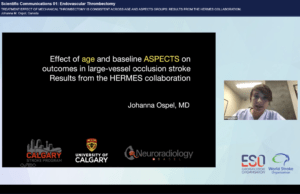 A study presented by Johanna Ospel (University of Calgary, Calgary, Canada) at the European Stroke Organisation and the World Stroke Organization joint virtual conference (ESO-WSO 2020, 7-9 November, virtual), has shown that there is no reason to withhold endovascular therapy (EVT) from patients regardless of their age and Alberta Stroke Program Early CT Score (ASPECTS) score.
A study presented by Johanna Ospel (University of Calgary, Calgary, Canada) at the European Stroke Organisation and the World Stroke Organization joint virtual conference (ESO-WSO 2020, 7-9 November, virtual), has shown that there is no reason to withhold endovascular therapy (EVT) from patients regardless of their age and Alberta Stroke Program Early CT Score (ASPECTS) score.
It is often assumed that the age of a patient and their ASPECTS score interact with each other, meaning that they are given different treatments. For example, a younger patient may be treated with EVT routinely, however, for elderly patients, treatment with EVT is often avoided. This study shows no evidence that this is the case, as commented by Ospel, “in our dataset, the treatment effect of APECTS does not significantly change across the age spectrum and the other way around.”
The main aims of the study were to assess the combined effect of age and ASPECTS outcome in acute ischaemic stroke due to large vessel occlusion when treated with or without EVT; and to explore whether there was a difference in EVT treatment effect between age/ASPECTS subgroups.
The study looked at 1,735 subjects, the median aspect score was eight and the median age was 67.6. A good outcome for patients was seen as having a modified Rankin score (mRs) of 0-2.
Ospel noted that as part of the study they had a low sample size of elderly patients with a low ASPECT score. This can in part be attributed to a sampling bias on the part of the studies used, which seem more likely to select fitter and younger patients.
While this study did show no need to withhold EVT from older patients with low ASPECTS scores, for those patients over 75 with low ASPECTS score, their overall outcome was poor, with high mortality, regardless of treatment with EVT.
Ospel observed that this subgroup of patients, older patients with low ASPECTS scores, is an area which may need more study and discussion. This is in part because of the low sample size their study had access to, but also due to wider considerations for this subgroup.
One of these considerations is whether a mRs of 0–2 is really the best measure with this group’s outcome, due to their worse prognosis than those who are younger and fitter. In these cases, it might be possible to see a higher mRs score as being optimal.
Another consideration may be the healthcare resources in an area, as well as health insurance considerations. To this point, Ospel commented, “if you can only do a limited number of EVTs, the question becomes: should you perform EVT in those patients [older patients with low ASPECTS scores], or should you treat patients with a better prognosis first.”
Overall, the study suggests that all age ranges and ASPECTS scores may possibly benefit from treatment of EVT, however, raises some questions over whether EVT should be routinely performed on elderly patients, which needs further study and discussion. In this regard, Ospel finished her presentation by saying, “the answer to this question probably depends on the local healthcare resources, and infrastructure, as well as the patients’ wishes.”













